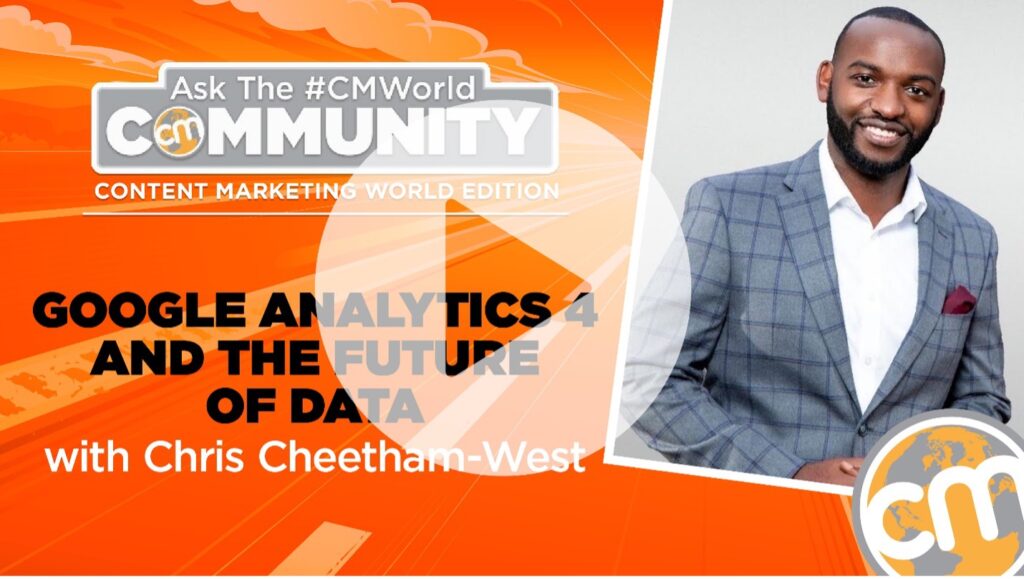
Google Analytics as you know it will soon be going away for good. Google will soon retire Universal Analytics and replace it with Google Analytics 4, but are content marketers ready for the transition? Did you know, if you’re not prepared, you will no longer be able to benchmark your website performance? The good news is that you still have time to prepare for this transition.
During this week’s Ask the #CMWorld Community livestream, CMI host Amanda Subler interviews CMWorld Chris Cheetham-West, Founder & President of LR Training, to chat about some steps to make sure you have a successful migration and how to make data work for your business.
Key Takeaways from the interview:
- Universal Analytics will be replaced by Google Analytics 4 next June. You should go in and set-up a profile now and learn about the changes and new features.
- Some of the new features include “bounce rate” will go away and instead you can look at “engagement rate” or “engaged sessions” and “goals” are changing to “conversions.”
- A fundamental data model difference in Google Analytics 4 is “events” which is basically whenever people go to your site and they do a given action. It’s important to understand events and how to use them.
Watch this interview then come hear Chris Cheetham-West speak at Content Marketing World 2022. Chris’s session is called “Google Analytics and the Future of Data.” You can read the full description here. You can check out the entire agenda here.
You can participate in the interactive Ask the #CMWorld Community livestreams most Mondays at Noon ET on LinkedIn, YouTube, Facebook or Twitter. Check out some of the past interviews in this playlist.
Amanda Subler (06:06):
First of all, if marketers have been living under a rock and they don’t realize this yet, why is Universal Analytics going away? And when can they expect this big change?
Chris Cheetham-West (06:20):
Thanks for the question. So, it’s going to be going away next year. So next summer. So now is the time to prepare for this. Now is the time for you to pretty much understand what are the changes that are going to happen. And one thing I always tell clients is that you want to understand the basics of the recurring Google Analytics before you kind of can really grasp the Google Analytics 4, because there’s so many different changes that can help you out, help your business, help you understand your audience a little bit more, but just in general, it’s going away. Because I personally feel that they at Google, they realize all the issues we were having, and they also realize how people are using the platform. I’ve personally been using the platform for about 10 years. And so, I’ve noticed certain things that I think to myself, man, maybe they should change this a little bit and they notice these changes. So now they’re moving towards a newer kind of experience based off of how the web is right now. And based off how people build websites, how people attend websites, how people go on their mobile devices. So that is the main reason for the change. And so, and that change is going to take place next year, next summer.
Amanda Subler (07:35):
And Rob is asking, from Philly, he wants to know, is it truly going away or is this like another rebrand?
Chris Cheetham-West (07:44):
Yeah, it’s going away. So, I mean, we can’t predict if it’s actually going to go away, but from what I’ve seen from the emails, from my experience. Yeah. So, it’s going to be that transition is going to happen in June. So, you definitely want to prepare right now.

Amanda Subler (08:02):
All right. So, what’s the main difference between Google Analytics 3 and 4 and what are some of the new tools that marketers should really know about?
Chris Cheetham-West (08:12):
There are so many different useful tools in this new experience that you’re going to have when it comes to Google Analytics 4. So many people are familiar with bounce rate. So, bounce rate has been used for years and years. So even when I first started with Google Analytics, and I would always tell my clients that bounce rate is so important. And that’s because it really gives you an idea of what the person is doing when they get to your site. And if your site is engaging to them. So that’s going to change. That’s going to be called engagement rate. So, there’s not going to be any bounce rate anymore. So, it’s going to be called engagement rate. And why this happened is because Google realized that 10 years ago, people will go to webpages and they’ll look at the page, they’ll go through the pages, different section of a page, or contact us page, about this page, and then they’ll log out.
So that was a good way to figure out if people are actually engaging your site. So, did they go through your site to different pages before they left? But now as you can see, there’s so many different types of websites right now. So, if I start a website and I want a marketing event, maybe I only have a landing page and I don’t really care if people go through different web pages, I just want them to go to that one page and then they fill out their information and that’s it. So, within Google Analytics, currently, that’s going to seem like it’s not an effective page. That’s going to seem like people are bouncing 99% bounce rate. So, what they did was they did engagement rate now. So, you’re not going to see bounce rate, you’re going to see engagement rate. And so that kind of gives you an idea of how long people are on the site, as well as what actions they’re taking on the website.
So that’ll equal the engagement rate that you’re going to see in this new Google Analytics 4 platform. So that’s a one key area. Another area is goals. Anybody use goals out there? If so, you can put in the chat box. Anybody use goals? So, for years and years, I would tell clients that I’ll train them. When I trained them on Google Analytics, I told them to use goals to figure out if you are reaching your objectives, if you are actually getting results. So, let’s say for instance, you have a, a page on your site and people need to download a PDF. A goal could be you want X amount of visitors to come to your site and you want them to download that PDF. And once they download the PDF, that’s considered a goal, or once they hit a certain page, that’s a goal. Or if they hidden a certain amount of traffic, or if they play a video for a certain long time, that’s a goal.
And it was really useful. But now based on what Google has seen, they changed that to conversions now. So, it’s not going to be goals, it’s going to be conversions. And this is great because it kind of pushed us to move forward to that point where we are thinking about conversions. So, what is a conversion to us? What does success mean to us, and how can you continually create those conversions? And not only that, it’s a little bit easier to access within Google Analytics 4 platform versus how it used to be. I mean, it used to be just a small section where you have to kind of know and have experience with goals, but now it’s kind of revolves around conversions. So that’s two and three is events. Anybody do events? You can put in the chat box. Anybody do events or like create events for the brand now?
And this is what I was talking about in the intro where you want to kind of understand events before you move into Google Analytics 4. It’s great because you have time, you have time within the next year to understand how events work. Some people in here might be advanced. Some people might be beginner or intermediate, but from my experience, majority of the companies, large or small, they’re not really focusing on events, but an event is basically whenever people go to your site and they do a given action, maybe that’s press a play button on a video. Maybe that’s download a PDF or maybe that’s scrolling down on your page. So, all that is actions on your website. So, Google Analytics 4 revolves around events. So, one of the most popular events that people ask about is if I have a website and I’m linking to another website, not my, not another page, not an internal page, but linking to another website. Can I track that in Google Analytics? And yes, you can track that outbound click in Google Analytics, which is a great thing to have, but in the current analytics, you would have to input event, track and code in order to do that. So, you can do that. And that’s just a whole bunch of extra time, right? So now those events, most of them are automated for you.
Amanda Subler (13:12):
So why is it so important for marketers to prepare for this transition now? Are they going to be losing a lot of stuff if they’re not ready? Why is it so important?
Chris Cheetham-West (13:32):
Yeah. So, the data’s not going to really transfer over. So, I encourage people to get started right now by setting up those profiles because it is available to us. So, setting up that profile and also keeping your current analytics as well would be a good idea, because then you can kind of look at your data and you can get kind of get ready for this new, this new change. And I think it’s important because you want to understand where the data is right now. Like what kind of technology, what type of ways that we can connect with our audience right now and within the Google Analytics 4, there’s so many different ways that it can better enhance your idea of what your audience is doing. So, if you understand that, then you can talk with your team. You can make some key decisions on how to move forward and how to grow your brand online.

Amanda Subler (14:21):
Jodi is asking what’s the difference between an event and a goal? Did G4 rebrand goals?
Chris Cheetham-West (14:30):
Yeah. So, the difference, so in event is any type of action that happens on your website. So, this could be they’re scrolling down or they’re clicking a button, they’re clicking an outbound link to go to another website or they’re downloading something. So, any, all those are actions on people’s website. So that’s considered an event in the new event for a goal is, is specifically what you consider a goal. So, for example, for my business, a goal may be to get a hundred visitors in a day to a certain page on website. And then I can set that as a goal in Google Analytics. And then if I reach that goal, that’s considered a conversion. So that’s the difference. So, I always tell people a goal is really what you say it is. What kind of results do you want?
Amanda Subler (15:20):
We know it’s important. We got to get ready. So, what are some things that marketers need to make sure they do to prepare for this transition?
Chris Cheetham-West (15:30):
To prepare for this transition, I’ll say, just educate yourself. So, you attending this session right now is a really good opportunity for you to understand what’s going on. That’s the first step. So, you can, clap for yourself for that, right? So, understand what’s going on. And then second figure out, how can you create these additional profiles? If you currently use Google Analytics right now, log in, and it’s going to give you the option to add the Google Analytics 4 properly. So, this is not going to do anything to your current data. This is going to create a separate profile that you can then start to understand and use the data. So, the data will take a few days to come in, but eventually you’re going to see this new information and now guess what? You can play around with it. So that’s the second thing to do.
And third is figure out what type of content and results do you want to see? So, in the old analytics, I would tell many organizations that you need to create a dashboard, a dashboard of about nine different things that you want to look at. So, this could be social media, traffic. This could be search traffic. This could be advertising traffic. This could be even email marketing traffic. And then also this could even be another section for where your web visitors come from. So that I know that’s important for my business. I want to see what countries, what cities people are finding my site through. And so, I can understand what pages they’re going to and how long they’re spending on the site. So, I will create a dashboard for that. Also, maybe if you have an IT department, you want to see the load time of your website. You want to create an area where you can see exactly how your site is performing.
If you know this information from the current Google Analytics, Universal Analytics, you want to consider looking at the new Google Analytics 4 and trying to figure out what do you really want to get from it? What kind of content, what type of goals do you want to get? Because another area in the current Google Analytics 4 is it helps you to choose your audiences. So, if you want to focus on a specific audience, you can do that. If you want to segment your information, you can do that. I remember going to a networking event. It was a market association event a long time ago when I first started out in my career, and I would meet people that are in marketing. And one person I met, he says he works for USAA and he’s whole job is mobile marketing. I was shocked. Because I was like, your whole job is mobile marketing? Yeah, so all these years I started realizing people have different positions and some of their positions specifically focus on areas such as mobile marketing. So that might be a key focus in your Google Analytics 4 journey is, hey, you only want to see traffic in form of mobile traffic. So, all that is possible. So one is, go ahead and set the new profile. Two is play around with a little bit and three is figure out what do you want to get from your information? That’s going to help you get results.
Amanda Subler (18:41):
Great, Chris, and I know you have so much more in your session, you’re also going to be touching on this is a big one, the future of data and what that means for marketers. So, do you want to give us a quick overview of how they can make better decisions going forward or what they can look for forward to at your session at Content Marketing World?
Chris Cheetham-West (18:59):
My session, I like to use key examples. I like to make sure people can understand the information because listen, I’ve done three-day seminars only on Google Analytics. So, whenever people hear that they’re shocked because there’s so much information in here it’s used for it. Teams, communication teams, branding teams, large corporations, global teams, all the way to the small business. What I like to do is take out the key information that really matters to this audience and let people know that you can connect and it’s easy to get started. So, it can be overwhelming. You can be scared of all the data, but I always tell people, focus on what matters to your business and what matters your team. That way you go into analytics, and you can only focus on what matters to your team. So that’s what I’m going to bring to Content Marketing World is just information that people can use, that they can connect with, and they can use what relevant examples as well.






